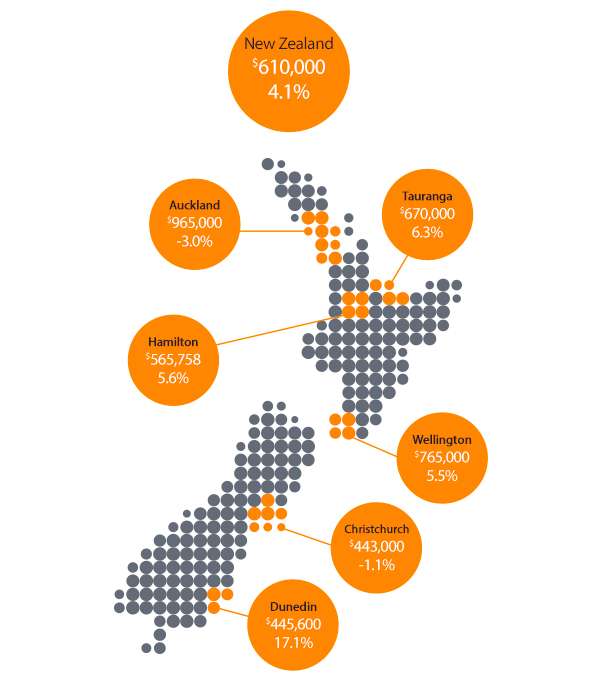Hastings and Whanganui are the hottest property markets in New Zealand right now, with the two towns recording the country's biggest annual leaps in house prices, according to new figures from OneRoof and its data partner Valocity.
The median value of all residential properties in Hastings rose 29.9 percent in the last 12 months to $500,000, while Whanganui's median value increased 26.1 percent to $265,000.
Three of the country's fastest growing suburbs for house prices were also in Whanganui: property values in Waverley, Milton and Whanganui Central all rose more than 30 percent in the last 12 months. The biggest house price surge was in Wairoa, in Hawke's Bay, where property values grew 52 percent year on year to $160,000.
OneRoof found that Whanganui had the highest sale price to CV ratio in the country, with houses in the town typically selling 1.55 times above CV. Hastings had the next highest sale price to CV ratio, at 1.44.
Start your property search
However, figures published in the OneRoof Property Report also show that some of country's most expensive housing markets are feeling the most pressure.
The median property value for Auckland City, which includes multi-million-dollar suburbs Herne Bay, Ponsonby and Remuera, dropped 3 percent year on year, while the median property value for the North Shore, which takes in the prestige beachside neighbourhoods Takapuna, Devonport and Campbells Bay, fell 2.8 percent (article continues after the interactive).
Use the interactive below to see how house prices in your suburb compares to those in the rest of NZ.
Auckland suburbs also endured the country's biggest year on year drops in house prices: Kumeu fell the hardest, with its median value dropping 23.7 percent to $1.14 million. Also falling hard were Bombay (-16.5 percent); Westmere (-12.9 percent and Albany (-12.1 percent).
OneRoof editor Owen Vaughan said: "Hastings and Whanganui are star performers for similar reasons. Both have a large share of relatively attractively priced homes, which has caught the attention of first home buyers and investors alike.
"However, it is important to put the surges in context. For Whanganui, the lift is coming off a very low base - the median value was $180,000 five years ago - and Hastings is finally catching up to where property values have been pushing in nearby Napier."
OneRoof found that affordability was the major contributing factor to the slowdown in Auckland. The share of new mortgage registrations to investors dropped to 14.3 percent, while movers remain below 10 percent. The largest buyer group remains first home buyers, who represented 27.4 percent of new registrations last month, although this is a slight decline on the month before.

Vaughan said: "Even though first home buyers make up the bulk of market activity, the pool of properties they are chasing is in the sub-million dollar bracket and that's shrinking by the day (perhaps an indication to overstretched investors with properties in that bracket that now could be a good time to sell)."
However, James Wilson, director of valuation at Valocity, said the tide could be turning in Auckland. "The drop in mortgage rates, on the back of the Reserve Bank’s decision to reduce the OCR to 1 percent, has lowered the cost of buying for first home buyers and investors.
"The lowering of interest rates and the spring weather could also tempt existing homeowners to trade up."
The OneRoof-Valocity figures show Christchurch's housing market has barely shifted in the last 12 months, with its median value down 1.1 percent to $440,000 in the last 12 months. Wellington's median value was up 5.5 percent year on year to $765,000, although the fact that was no change in the last three months indicates the foot is coming off the accelerator in the capital.
Hamilton and Tauranga's housing markets are relatively buoyant, with the median value for Hamilton up 5.6 percent in the last 12 months to $565,000 and Tauranga's up 6.3 percent on the year before to $670,000.
Dunedin remains the strongest performer among the main urban centres in New Zealand. Annual house price inflation is currently 17.1 percent and quarterly growth came in at 7.2 percent, making Dunedin the only city experiencing double-digit value growth. The median value for the city is of $445,000.
The national median value (including Auckland) currently sits at $610,000, up just 0.82 percent on the last three months and 4.1 percent annually. However, given that a lot of the ”slowdown” has been caused by challenges Auckland, the growth picture is a lot brighter once Auckland is removed: quarterly growth of 1.77 percent and annual growth of 6.19 percent.





































































